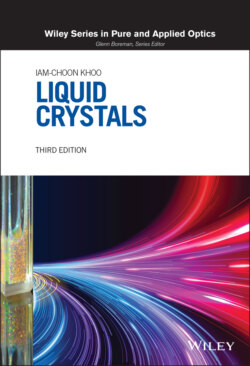Читать книгу Liquid Crystals - Iam-Choon Khoo - Страница 25
1.5.1. Nematic LC Cells Assembly
ОглавлениеFor nematics, two commonly used alignments are the so‐called homeotropic and homogeneous (or planar) alignments, as shown in Figure 1.19a and b, respectively. To create homeotropic alignment, the cell walls are treated with a surfactant such as HTAB (hexadecyl trimethyl ammonium bromide) [26]. These surfactants are basically soaps whose molecules tend to anchor themselves perpendicular to the wall and thus impart homeotropic alignment to the bulk liquid crystal molecules.
Industrial processing of liquid crystals‐based devices or display screens, including various transparent conductive coating of the cell windows for electro‐optical applications, is understandably more elaborate, often held as proprietary information or patents. In the laboratory, a quick and effective way to make a homeotropic nematic liquid crystal is as follows: dissolve 1 part of HTAB in 50 parts of distilled deionized water by volume. Clean two glass slides (or other optical flats appropriate for the spectral region of interest). Dip the slides in the HTAB solution and slowly withdraw them. This effectively introduces a coating of HTAB molecules on the glass slides. The glass slides should then be dried in an oven or by other means. To prepare the nematic liquid crystal sample, place a spacer (Mylar or some nonreactive plastic) of desirable dimension and thinness on one of the slides. Fill the inner spacer with the nematic liquid crystal (which should be heated to the isotropic phase), and immediately place the second slide on top and secure the two slides with a clip. Once assembled, the sample should be left alone, and it will slowly (in a few minutes) settle into a clear homeotropically aligned state.
Figure 1.19. Nematic liquid crystal cells: (a) homeotropically aligned; (b) planar or homogeneously aligned.
Planar alignment can be achieved in many ways. A commonly employed method is to first coat the cell wall with some polymer such as PVA (polyvinyl alcohol) and then rub it unidirectionally with a lens tissue. This process creates elongated stress/strain on the polymer and facilitates the alignment of the long axis of the liquid crystal molecules along the rubbed direction (i.e. on the plane of the cell wall). As a matter of fact, there is a commercial so‐called rubbing machine for preparing planar cell windows. Another method is to deposit silicon oxide obliquely onto the glass slide.
For preparing a PVA‐coated planar sample in the laboratory, the following technique has proven to be quite reliable. Dissolve chemically pure PVA (which is solid at room temperature) in distilled deionized water at an elevated temperature (near the boiling point) at a concentration of about 0.2%. Dip the cleaned glass slide into the PVA solution at room temperature and slowly withdraw it, thus leaving a film of the solution on the slide. (Alternatively, one could place a small amount of the PVA solution on the slide and spread it into a thin coating.) The coated slide is then dried in an oven, followed by unidirectional rubbing of its surfaces with a lens tissue. The rest of the procedure for cell assembly is the same as that for homeotropic alignment.
Ideally, of course, these cell preparation processes should be performed in a clean room and preferably in an enclosure free of humidity or other chemicals (e.g. a nitrogen‐filled enclosure) in order to prolong the lifetime of the sample. Nevertheless, the liquid crystal cells prepared with the techniques outlined above have been shown to last several months and can withstand many temperature cycling through the nematic–isotropic phase transition point, provided the liquid crystals used are chemically stable. Generally, nematics such as 5CB and E7 are quite stable, whereas MBAA (p‐methoxybenzylidene‐p′‐n‐butylaniline) tends to degrade in a few days.
Besides these two standard cell alignments, there are many other variations such as hybrid, twisted, supertwisted, and fingerprint; multi‐domain vertically aligned; and so on. In recent years [17, 27], photo‐alignment of dye‐doped cell window surface has also been shown to be highly effective for imparting the desired liquid crystal director axis arrangement.
For smectic‐A, the preparation method is similar to that for a homeotropic nematic cell. In this case, however, it helps to have an externally applied field to help maintain the homeotropic alignment as the sample (slowly) cools down from the nematic to the smectic phase. The cell preparation methods for surfaced‐stabilized FLC (SSFLC) operation is more complicated as it involves surface stabilization [28, 29]. On the other hand, Sm‐A* cells for soft‐mode (SM‐FLC) operation are easier to prepare using the above methods [30].
